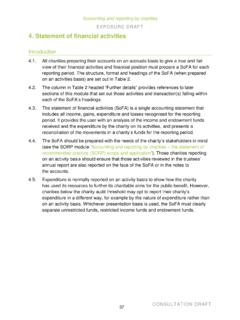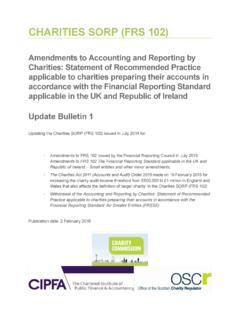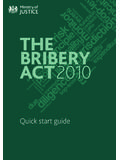Transcription of 24. Accounting for groups and the ... - Charities SORP
1 Accounting and reporting by Charities EX POSU RE D RAF T CONSULT AT ION DR AF T 158 24. Accounting for groups and the preparation of consolidated accounts All Charities preparing consolidated accounts, whether as a requirement of company or charity law or on a voluntary basis, must follow this module. It applies to consolidated accounts prepared by Charities under the FRSSE or FRS 102. Charities reporting under the FRSSE should refer to section 16 of the FRSSE and Charities reporting under FRS 102 should refer to section 9 of FRS 102 for more information. consolidated accounts are prepared by a parent charity and include all of the resources controlled by the parent charity. A parent charity is a charity that has one or more charitable or non-charitable subsidiaries (subsidiary entities). Where consolidated accounts are prepared, the Accounting disclosures required of the charity by other applicable modules are extended to the group accounts (unless otherwise stated).
2 This module sets out: the legal requirements to prepare consolidated accounts; what consolidated accounts are; how control is identified; the consolidation procedures and Accounting for minority interests; Accounting for the acquisition and disposal of non-charitable subsidiaries; and the disclosures required where consolidated accounts are prepared. Legal requirements to prepare consolidated accounts A parent charity must prepare consolidated accounts to include all of its subsidiary entities where the accounts preparation is a requirement of: company law; charity law in the relevant legal jurisdiction(s); or any other statutory or mandatory framework applicable to the charity. Details of the thresholds at which the preparation of consolidated accounts is mandatory are set out in Appendix 3, Thresholds for the UK and the Republic of Ireland . What are consolidated accounts? consolidated accounts, which are also known as group accounts, combine the activities, assets and liabilities of the reporting charity with those of the subsidiaries Accounting and reporting by Charities EX POSU RE D RAF T CONSULT AT ION DR AF T 159 it controls.
3 consolidated accounts include the activities and funds of any subsidiary charity that is controlled by a parent charity as its trustee. consolidated accounts present the financial performance and financial position of the Accounting group as though it were a single economic entity with a unity of trusteeship. consolidated accounts must include any associates or joint venture entities in which the parent charity has an interest. Refer to the separate SORP modules Accounting for associates and Accounting for joint ventures for more information. The headings used in the Accounting statements must state that they present the consolidated statement of financial activities and consolidated balance sheet of the parent charity and its subsidiaries, and the consolidated statement of cash flows . consolidated accounts must also include any special purpose entity that is controlled by a parent charity and created to undertake an activity for the benefit of the parent charity.
4 For more information about what constitutes a special purpose entity and the criteria for its consolidation, refer to section 9 of FRS 102. A subsidiary is not excluded from consolidation because its business activities are dissimilar to those of the parent charity or other entities within the consolidation. Nor is a subsidiary excluded from consolidation because it operates in a jurisdiction that imposes restrictions on transferring cash or other assets out of that jurisdiction. If immaterial subsidiaries, associates or joint ventures are excluded from the consolidated accounts, these are treated as investments and are reported at cost or fair value as appropriate. For more information, refer to the SORP modules Balance sheet , Accounting for associates or Accounting for joint ventures . How control is identified A parent charity consolidates the subsidiaries it controls. Control is the power to govern the financial and operating policies of an entity in order to obtain benefits from its activities.
5 Control is made up of two elements: power and benefit. The underlying principle is that the parent charity exercises control to obtain benefit from its interest in the subsidiary. The parent charity is deemed to exercise control over a subsidiary if it has both the power to govern and the ability to benefit. The power element is presumed to exist when the parent charity owns, directly or indirectly through its subsidiaries, more than half the voting power of an entity. However, control can also exist when the parent charity directly or indirectly controls half or less than half of the voting power of an entity, if it has: power over more than half of the voting rights by virtue of agreement with other investors; the power to govern the financial and operating policies of the entity under a statute or an agreement; Accounting and reporting by Charities EX POSU RE D RAF T CONSULT AT ION DR AF T 160 the power to appoint or remove the majority of the members of the board of directors or equivalent governing body, and control of the entity is by that board or body; or the power to cast the majority of votes at the meetings of the board of directors or equivalent governing body, and control of the entity is by that board or body.
6 The nature of the control a parent charity exercises differs in its character between non-charitable subsidiaries and controlled Charities . Where a charity exercises control as an owner or investor in a non-charitable subsidiary, it does so to benefit from the cash flows and the financial return from that investment. The parent charity can exercise control through trusteeship, which gives a parent charity the ability to govern the financial and operating policies of the subsidiary charity. The consolidated accounts show the total funds under the trusteeship of the parent charity. The power element of control of one charity by another can be identified through: sole trusteeship; powers to appoint and/or remove a majority of the trustees; the terms of a formal agreement or arrangement; or the provisions of a clause in the governing document or a legislative provision. Having trustees in common does not in itself demonstrate that the power element is present. Also, simply being the sole or main funder of another charity or entity is insufficient to demonstrate that the power element is present.
7 While the funding of one charity by another indicates a degree of concurrence of purposes, for control to exist the power element must be present. The benefit element of control is met where the purposes of the parent charity and its subsidiary charity are concurrent. The purposes of the parent charity do not have to be identical to those of its charitable subsidiary, nor do they need to encompass all the purposes of the charitable subsidiary. For concurrence, the purposes of the parent charity have to be similar enough to those of the subsidiary that the activities of the subsidiary can be seen to contribute to the purposes and aims of the parent charity and to benefit the parent charity s beneficiaries. When considering whether the purposes are concurrent, judgement is required. The charity should consider whether the preparation of consolidated accounts will give a true and fair view of the nature of control it can exercise and its ability to benefits from its interest as the trustee of another charity.
8 The parent charity might benefit where the services and benefits provided by the subsidiary charity to its own beneficiaries also contribute to the purposes of the parent charity. The funds of the subsidiary charity are restricted to its own purposes and, unless the parent and subsidiary charity have identical purposes, the subsidiary will be a separate component of the group s reported restricted funds. The reporting of a restriction over the use of a subsidiary charity funds is important for the understanding of the consolidated accounts and of how funds held by Accounting and reporting by Charities EX POSU RE D RAF T CONSULT AT ION DR AF T 161 charitable subsidiaries may be used. For example, the funds of a subsidiary charity are not normally available to the creditors of the parent charity in the event of the latter s insolvency. Consolidation procedures and Accounting for minority interests For guidance on how to apply the consolidation procedures, Charities should refer to section 9 of FRS 102.
9 In particular, a parent charity must ensure that: the consolidation is undertaken on a line-by-line basis; balances and transactions between the parent and the subsidiary are eliminated; the accounts of the parent and its subsidiaries have, if practicable, the same reporting date; and uniform group- Accounting policies are adopted for transactions and other events or conditions in similar circumstances. Transactions between a parent and subsidiary charity are netted off on consolidation. However, where a transaction constitutes a transfer between a class of fund within the group for example between the unrestricted funds of the parent charity and restricted subsidiary charity funds then a compensating value must be shown in the group statement of financial activities (SoFA). In the consolidated balance sheet, the charitable funds of the parent charity and the subsidiary charity must not be consolidated on a line-by-line basis; instead, the subsidiary charity should be shown as a component of restricted funds unless the subsidiary and parent have identical purposes.
10 Where the purposes are identical, the unrestricted funds of the subsidiary are a component of the unrestricted funds of the group. When a charity acquires a subsidiary, the net funds it acquires will not be a component of the brought forward fund balances. If the assets exceed the liabilities acquired, a gain is shown separately within income normally as a gift (donation). Conversely, if liabilities exceed the assets acquired then a net loss is shown separately in charitable expenditure. When the gain or loss is material, it should be presented in the consolidated SoFA as an exceptional item. In some cases, a parent charity may not own the entire equity of a subsidiary. In this case, a minority interest may need to be recognised. A minority interest exists where a third party has a right to dividends or the distribution of resources, a claim on the net assets of the subsidiary through the holding of equity or significant influence through its voting power. Where a minority interest exists, it is important to consider the substance of its interest as well as legal form.





